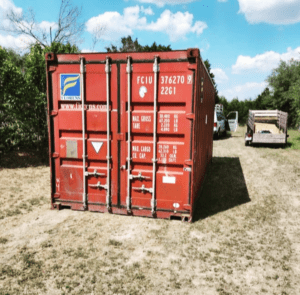Site Preparation for a Smooth and Safe Delivery Process
When it comes to shipping container delivery, preparation is everything. A well-prepared site means fewer delays, fewer headaches, and a smooth drop-off process. Whether you’re a farmer setting up a storage unit, a contractor expanding a job site, or a small business owner adding workspace, these simple steps will help ensure your container arrives safely and efficiently.
Clear the Drop-Off Zone
Obstacle-Free Zone
Before your container arrives, take time to clear the delivery area. Remove any debris, rocks, tree branches, or other obstacles that could block the truck or interfere with placement. Even small obstructions can cause unnecessary delays.
✔ Check for:
- Piles of construction material, tools, or equipment
- Overhanging tree branches or power lines
- Loose gravel or uneven surfaces
- Snow, mud, or excessive moisture that could cause traction issues
Pro Tip: Spending 30 minutes clearing the site now will save you hours of potential problems later.
Additionally, consider the surrounding area. If your container will be placed near a structure, ensure there’s enough room to maneuver and position it correctly. If the drop-off spot is on a slope, plan accordingly to level the container properly.

Ensure Proper Site Access
Access Matters
A container delivery truck is large, typically requiring at least 12 feet of width, 14 feet of vertical clearance, and 125 feet of straight-line clearance to enter your site safely. If access roads are too narrow, have tight turns, or are blocked, delivery may be delayed or impossible.
✔ Ask yourself:
- Are the access roads wide enough for a truck to enter and turn around?
- Is there a steep incline or soft ground that could cause issues?
- Do you need to move any fences, gates, or parked vehicles?
- Does your site have the required 125 feet of straight-line clearance for the truck to properly align and offload the container?
Pro Tip: If you’re unsure, walk the path yourself or take a few pictures and share them with your container supplier before delivery.
Also, take seasonal conditions into account. Wet or snowy weather can make access roads slippery, while dry conditions might cause excessive dust. Planning ahead can prevent complications.
Prioritize Safety
Safety First
A safe site protects your workers, the delivery team, and your investment. Proper preparation ensures the container can be placed without incident.
✔ Steps to improve safety:
- Place clear signage directing where the container should go
- Use cones or barriers to keep unauthorized personnel out of the drop zone
- Ensure the ground is firm enough to support the container and truck weight
Pro Tip: Safety isn’t just about preventing injuries—it also keeps your delivery on schedule and avoids costly mistakes.
Consider adding temporary lighting if the delivery is happening in low-light conditions. Visibility is key to preventing accidents and ensuring smooth operations.
Check for Compliance and Permits
Know the Rules
Depending on your location, you may need permits or approvals before delivery. Local zoning laws or HOA regulations can sometimes impact where and how a container can be placed.
✔ What to check:
- Does your county require a permit for large deliveries?
- Are there any restrictions on placing a shipping container on your property?
- Do utility companies need to be notified before delivery?
Pro Tip: Calling your local planning office before delivery can prevent costly surprises later.
Additionally, some areas may have weight restrictions on roads or require temporary permits for oversized vehicles. It’s best to check in advance.
Consider Environmental Factors
Protect the Site
If your site is in a rural or sensitive area, take steps to minimize environmental impact. Poor preparation can lead to erosion, water pooling, or even damage to nearby plants and wildlife.
✔ Best practices:
- Use gravel or concrete pads to create a stable base
- Avoid placing the container near water sources or protected land
- Consider using wooden planks or beams to distribute weight evenly
Pro Tip: If placing the container on soil, ensure it’s dry and compacted to avoid shifting over time.
Another environmental consideration is drainage. Poor drainage can lead to water pooling around the base of the container, increasing the risk of rust and instability. Ensure the site has proper grading to divert excess water away.
Maintain Clear Communication
Communication is Key
Miscommunication is one of the biggest causes of delivery delays. Make sure everyone involved in the process is on the same page.
✔ Steps to take:
- Confirm the delivery time and location with your supplier
- Discuss any site-specific concerns before the truck arrives
- Have someone on-site during delivery to oversee the process
Pro Tip: A five-minute phone call before delivery can prevent major issues on the day of arrival.
It’s also a good idea to keep backup contacts available in case of last-minute changes or emergencies.
Conclusion: A Smooth Delivery Starts with Preparation
Proper site preparation is the key to a hassle-free shipping container delivery. By following these steps—clearing the drop-off area, ensuring access, prioritizing safety, checking for regulations, considering environmental factors, and maintaining clear communication—you’ll avoid unnecessary complications and set the stage for a smooth installation.
📢 Next Steps:
- Need more details? Read our full delivery guide here
- Ready for a quote? Fill out our no-obligation form now
FAQ: Site Preparation for Shipping Containers
How much space do I need for container delivery?
You should have at least 12 feet of width, 14 feet of height clearance, and 125 feet of straight-line clearance. Also, allow extra space for the truck to maneuver.
Do I need a foundation for my shipping container?
While not always required, a level foundation (gravel, concrete, or wooden blocks) can prevent sinking and shifting over time.
What if my site has soft or muddy ground?
Consider adding gravel or concrete pads to stabilize the area before delivery. Soft ground can cause the container to sink.
Can I place a shipping container on grass?
Technically, yes, but it’s not recommended. Grass can lead to moisture buildup and container corrosion over time.
Do I need a permit for a shipping container on my property?
Some areas require permits, especially for long-term placement. Check with your local zoning office before delivery.
Get quote!

No strings attached 💯
Pingback: What You Need to Know About Shipping Container Delivery – UC containers